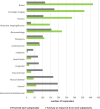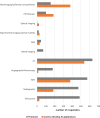Impact of artificial intelligence on radiology: a EuroAIM survey among members of the European Society of Radiology
- PMID: 31673823
- PMCID: PMC6823335
- DOI: 10.1186/s13244-019-0798-3
Impact of artificial intelligence on radiology: a EuroAIM survey among members of the European Society of Radiology
Abstract
We report the results of a survey conducted among ESR members in November and December 2018, asking for expectations about artificial intelligence (AI) in 5-10 years. Of 24,000 ESR members contacted, 675 (2.8%) completed the survey, 454 males (67%), 555 (82%) working at academic/public hospitals. AI impact was mostly expected (≥ 30% of responders) on breast, oncologic, thoracic, and neuro imaging, mainly involving mammography, computed tomography, and magnetic resonance. Responders foresee AI impact on: job opportunities (375/675, 56%), 218/375 (58%) expecting increase, 157/375 (42%) reduction; reporting workload (504/675, 75%), 256/504 (51%) expecting reduction, 248/504 (49%) increase; radiologist's profile, becoming more clinical (364/675, 54%) and more subspecialised (283/675, 42%). For 374/675 responders (55%) AI-only reports would be not accepted by patients, for 79/675 (12%) accepted, for 222/675 (33%) it is too early to answer. For 275/675 responders (41%) AI will make the radiologist-patient relation more interactive, for 140/675 (21%) more impersonal, for 259/675 (38%) unchanged. If AI allows time saving, radiologists should interact more with clinicians (437/675, 65%) and/or patients (322/675, 48%). For all responders, involvement in AI-projects is welcome, with different roles: supervision (434/675, 64%), task definition (359/675, 53%), image labelling (197/675, 29%). Of 675 responders, 321 (48%) do not currently use AI, 138 (20%) use AI, 205 (30%) are planning to do it. According to 277/675 responders (41%), radiologists will take responsibility for AI outcome, while 277/675 (41%) suggest shared responsibility with other professionals. To summarise, responders showed a general favourable attitude towards AI.
Keywords: Artificial Intelligence; Machine Learning; Radiologists; Radiology; Surveys and Questionnaires.
Conflict of interest statement
The authors declare that they have no competing interests.
Figures





References
-
- Deshpande P, Rasin A, Brown E, et al. 2018 IEEE Life Sci. Conf. IEEE. 2018. Big Data Integration Case Study for Radiology Data Sources; pp. 195–198.
LinkOut - more resources
Full Text Sources
Miscellaneous

